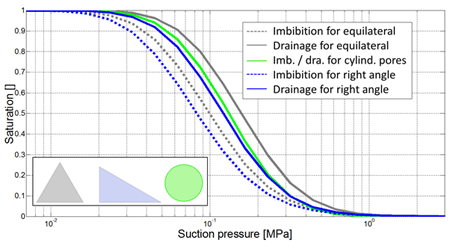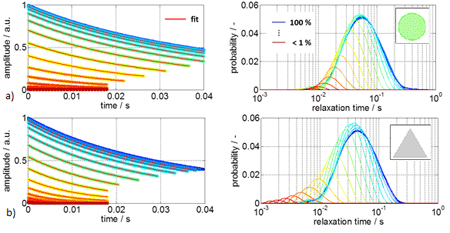continued as
 in Phase III
in Phase III
Micro-scale simulations of NMR and SIP signatures of partially saturated soils and their upscaling to laboratory and field scale




Research Area:
Geophysics, Hydrology
|

Figure 1: Water retention curves of drainage (dotted) and imbibition (lines) for the three different pore distributions with circular (green); triangular (equilateral - gray), (right angle - blue) cross-sections.
|
|

Figure 2: Calculated and fitted (red lines) NMR transient signals (left) for a fully and 19 partially saturated pore size distributions using circular (a) and equilateral triangular (b) capillaries and corresponding NMR relaxation time distributions (right).
|
NMR and SIP measurements on partially saturated soils are used to derive direct relations between soil structure and flow processes leading to improved estimations of multi-phase (water and gas) flow model parameters.
Structure and state of soils have considerable influence on their flow and transport properties in particular for the vadose zone. The signal responses of both, spectral induced polarization (SIP, or electrical impedance spectroscopy EIS) and nuclear magnetic resonance (NMR) are sensitive to pore parameters such as water content, pore structure and the inner surfaces of the water filled pore space of soils and rocks.
During this second project phase we aim at a method to characterize these pore parameters and transport properties of partially saturated soils based on joint inversion of SIP and NMR measurements.
To attain this goal we are developing numerical micro-scale models for multi-phase flow and NMR/SIP signatures.
Thusly a capillary pore model with a triangular cross section is being developed that currently simulates multi-phase flow along with respective NMR signatures of a porous system. Validation of the triangular pore model is carried out using both, laboratory data and numerical experiments, e.g. Lattice Boltzmann simulations (LBM).
Cooperation partner:
n/a